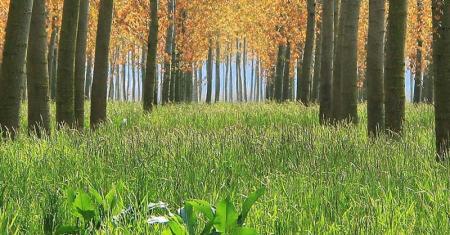
Area characterisation:
The Oglio Sud Regional Park is in Eastern Lombardy and represents an important ecological corridor in a typical agricultural landscape. The ecosystems involved are fluvial forests, such as willows, rushes or mixed lowland forest, and other natural riparian habitats, such as wetlands.
The area is mostly privately owned and, besides riparian forests and wetlands, has 1700 ha of poplar plantations, out of which only 25% are certified for responsible forest management under the Forest Stewardship Council (FSC). Since 2017, these farms are required to retain 10% of their land as a “representative area”, restoring close-to-nature ecosystems.
Objective:
This case study from the SINCERE project had the goal to:
- Set up a partnership between the regional park and local poplar plantations to increase the sustainable management of the plantations while increasing funding for restoration of crucial areas within the regional park.
- Bring together farmers into a certification group, facilitating certification and reducing costs, while benefitting the natural environment of the regional park.
- The innovative mechanism (IM) consists of a Payment for Biodiversity Conservation Scheme under the common framework of FSC certification.
Potential impacts/benefits:
Given the time horizon, it is difficult to measure and evaluate the possible effect on biodiversity in the conserved areas. The public will likely enjoy improved recreational services as a result of the creation of a natural forest. If made aware, will also benefit from the existence values related to biodiversity conservation. Poplar plantation owners will likely have an advantage by satisfying Forest Stewardship Council (FSC) requirements at a lower cost than would otherwise have been possible for them. This in turn is what drives their willingness to fund the exchange.
Actions:
This case study is a public-private partnership where private poplar plantations finance biodiversity conservation to satisfy requirements of the certification of timber products under the Forest Stewardship Council (FSC) framework.
A partnership was established between poplar plantation owners and the public park, where the former pays the latter to conserve a specific area for biodiversity purposes. The innovative mechanism (IM) has a solid construction with well-defined incentive structures: the poplar plantation owner finances a regional public park to set aside land for biodiversity conservation and, as a result, fulfills part of the requirements for obtaining FSC certification for the poplar plantation.
The case study partner Etifor facilitated contacts and meetings between poplar plantations and the Park Authorities, which resulted in the signature of five-year agreements.
The FSC certified poplar plywood industries also wanted to contribute to setting aside land and conserving biodiversity by sponsoring the Park, showing that the instrument has been accepted by the market exchange actors.
The agreements between owners of the poplar plantations and the parks have enabled the creation of 4.4 hectares of natural forest and secured better conditions for about 108 hectares of natural forests. Crucially, the area and improved quality of habitats for the benefit of biodiversity is a direct result of this IM.
Transferability of result:
National geographical upscaling: Building on the experience of the process of engaging different actors, this innovative mechanism (IM) could be upscaled to other plantations throughout Italy. However, even if demand for certified wood products in Italy is increasing, the participating poplar plantations have experienced problems in obtaining the expected price premium for their certified wood.
Upscaling to other schemes: The IM has similarities to several offsetting schemes. An obvious upscaling option is to consider if the other major forest certification scheme, PEFC, would be willing to accept similar offset arrangements. However, differences between the two certification schemes casts doubt on the possibility to develop a scheme with the PEFC standard.
Upscaling in scope: The principles in this IM are related to other offsets schemes that target other ecosystems and ecosystem services. Their feasibility, validity and performance often depend on the overall legal framework within which they function. When they go beyond legal requirements, more attention is needed for procedures ensuring transparency and credibility of the transactions and their environmental impacts. Crucial to these are additionality and permanence of the services provided.
Upscaling to other countries: The demand for biodiversity protection is ubiquitous and in the broad sense this IM has potential for upscaling in many other countries, especially those which trade on markets where FSC certification is valued. The additionality of the IM could be of concern; therefore, the link between certification and the actual conservation should be clear and strong to avoid discussions about greenwashing. The protection provided by the supplier needs to be documented in a way that allows assessment on the additional forest ecosystem services provision implied by the contracted exchange.
Organisations:
NBS goals:
- Restoring ecosystems and their functions